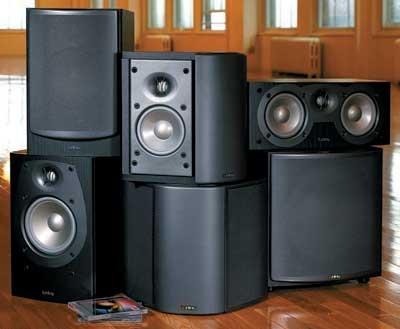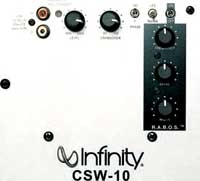Infinity Beta Home Theater Speaker System

Back in hi-fi's golden age, there used to be hot debates over "East Coast" vs. "West Coast" sound - no doubt a tame forerunner of the hip-hop wars of the '90s. East Coast speakers were thought to be smooth and mellow, with "concert-hall" sound best suited to classical music and jazz. West Coast models were bright and punchy - just the ticket for loud rock & roll.
Of course, this was largely bunk. There were plenty of "hot" speakers made back east and lots of smooth California models. For its part, Infinity Systems of Chatsworth, California, always avoided the labels and got on with the business of simply making excellent speakers, including some of the more innovative (and expensive) designs ever sold.
Infinity's new Beta speaker line is priced squarely in home theater's upper-middle-class. The suite we put together included the larger of two bookshelf models, the Beta 20, for the front left/right positions, the Beta C250 center speaker, a pair of Beta ES250 surround speakers, and the unusually powerful and compact CSW-10 subwoofer.
PDF: Fast FactsFor this report, I placed the Beta 20s on stands, the C250 atop my 30-inch widescreen HDTV, and the ES250s on my usual high, side-wall shelves - the same positions normally occupied by my reference speakers. I put the CSW-10 in my tried-and-true subwoofer spot, a bit to the left and behind the left front speaker.
 Though small in size, the CSW-10 is a big part of this system's story. Inside this modest but surprisingly heavy cube are a single 10-inch driver, a 650-watt BASH amp (one of today's super-efficient "smart" amplifier topologies), and Infinity's Room Adaptive Bass Optimization System (RABOS). Besides the three knob controls on the sub itself, RABOS comprises a test CD, a sound-level meter, some "audio-log" graph paper, and a special ruler to help you calibrate the system. All of this is intended to help you get the best possible sound in your room. Here's how it works: With the meter at your listening position, you balance speaker levels, then play test tones on the CD and plot the meter readings on the graph paper. The result is a graph of the subwoofer's frequency response. Then you overlay the ruler on the graph to find how to set the sub's Level, Width, and Frequency controls for optimal bass performance.
Though small in size, the CSW-10 is a big part of this system's story. Inside this modest but surprisingly heavy cube are a single 10-inch driver, a 650-watt BASH amp (one of today's super-efficient "smart" amplifier topologies), and Infinity's Room Adaptive Bass Optimization System (RABOS). Besides the three knob controls on the sub itself, RABOS comprises a test CD, a sound-level meter, some "audio-log" graph paper, and a special ruler to help you calibrate the system. All of this is intended to help you get the best possible sound in your room. Here's how it works: With the meter at your listening position, you balance speaker levels, then play test tones on the CD and plot the meter readings on the graph paper. The result is a graph of the subwoofer's frequency response. Then you overlay the ruler on the graph to find how to set the sub's Level, Width, and Frequency controls for optimal bass performance.




























































